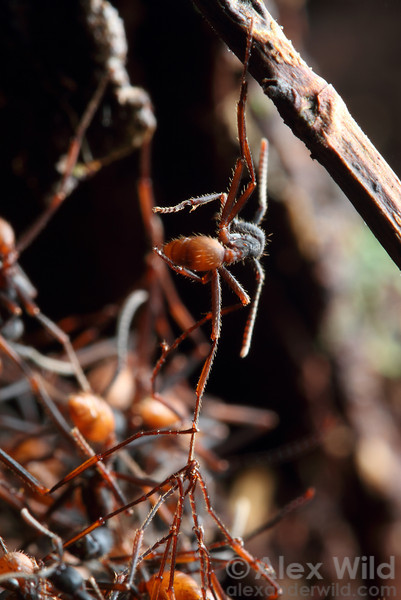Habitat and Geography
Eciton burchellii typically have a 35 day activity
cycle. In the first 20 days, the colony will take shelter in a
bivouac, a temporary above ground nest in which most cover is
provided by the worker ants themselves (Meisel 2006). This is
achieved by linking their hooked arms together and forming a
cylindrical mass. In this bivouac are swarms ranging anywhere
from 150,000 to 700,000 workers (Wildscreen 2013) . “Raids” for
food are also conducted daily during this time (Amateur
Entomologists’ Society 2013). These raids flush out thousands of
arthropods and other organisms in which the Army Ants and other
army ant following creatures prey upon. These Army Ants create
these bivouacs that are normally found near brush piles, tree
trunks, beneath fallen logs, or inside logs and hollow trees
(Wildscreen 2013). In the center of the bivouacs are thousands
of immature life forms of Army Ants, one single queen, and
around a thousand males (Smith and Haight 2007, Garnier et. al.
2013, Encyclopedia of Life 2013, Animal Diversity 2012). One
major part of keeping the immature forms healthy is to keep a
consistent temperature. They have developed a variety of
individual and colony-level responses to both limit such
encounters and minimize their risks (Meisel 2006). The ants that
form the bivouac are able to regulate temperature accurately
within plus or minus 1°C, but are extremely sensitive to
temperatures greater than 43°C (Franks 1989, Meisel 2006). The
environment that these ants live in can often have lethal
temperatures, which is why the responses that E. burchellii
have drive the movability and foraging effectiveness of each
colony (Meisel 2006).
.jpg)
Most colonies of E. burchellii are located in the
northern parts of South America and in regions of Central
America (Animal Diversity 2012, BBC 2013, Encyclopedia of Life
2013). These ants are considered a forest interior species but
colonies are reported routinely by rural people to pass through
homes and gardens and to utilize remnant forest patches (Meisel
2006).They prefer a very humid and warm climate with a lot of
forestry for cover. These ants are known to create their
bivouacs several meters off the ground, but most nests are on
the ground and they are mainly only seen in agricultural open
areas when venturing and raiding for food (Animal
Diversity 2012,
Encyclopedia of
Life 2013). It is species is that is easily characterized by
cyclical reproduction that drives foraging behavior and colony
mobility (Franks 1989).

Go on to Reproduction and Life History
Go back to Classification